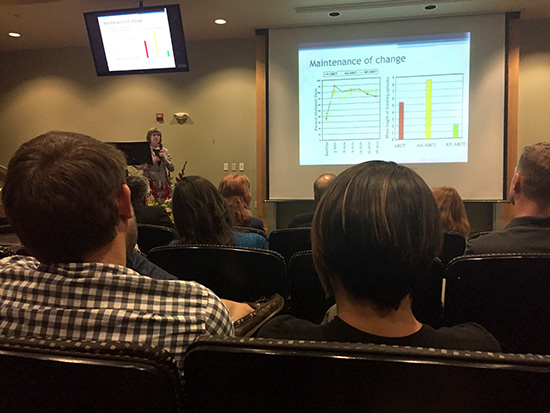UNM community honors Dr. McCrady for her lifetime of research
The UNM community honored psychology professor and director of Center on Alcoholism, Substance Abuse and Addictions Dr. Barbara McCrady’s work on April 4 at the 63rd Annual Research Lecture.
Her lecture “‘Til Death Do Us Part: A Lifetime of Research to Better Understand and Treat Alcohol Use Disorders in the Family” focused on her career in psychology, particularly the effectiveness of conjoint therapy and alcoholism in women.
Most of McCrady’s research focuses on alcohol behavioral couple therapy (ABCT) when treating alcohol disorders. ABCT involves the person with the alcohol problem coming in to treatment along with their significant other. McCrady said the three goals ABCT hopes to accomplish is to get the patient to stop drinking and maintain abstinence, help the partner learn behaviors to cope with drinking and support change, and improve the intimate relationship between the patient and the partner.
Later in her career, McCrady decided to conduct another study focusing on women.
“We were really struck by how often the women who called did not want couples therapy,” McCrady said.
The study was designed to allow women to choose whether they wanted to attend individual therapy or couple therapy.
“Overwhelmingly, they chose individual therapy,” McCrady said.
There were three main reasons why women chose individual over couple therapy, according to McCrady. One was the desire to change on her own. The woman felt that it was her problem, so she should be the one to fix it. There were also logistical barriers to the partner attending, especially if the couple had children and needed childcare. Lastly, there were concerns about the relationship, feeling that it was a little rough and wanted to work out their own problems by themself.
For the women who chose couple therapy, the two reasons for that decision were a desire to have a partner understand her needs and concerns about the relationship and wanting to make it better, McCrady said.
At the end of the study, McCrady learned that couple therapy could be used with individual therapy, as well as that women did not prefer couple therapy over individual therapy.
McCrady came to the University of New Mexico in 2007. She said she’s grateful to all of the colleagues she has gotten to work with.
“We’ve just had wonderful experiences,” McCrady said.
Around 2007, McCrady wanted to shift. She felt that she had developed a solid model for couple therapy, and now wanted to look at mechanism of change research. McCrady compared clinical trials to horse races, where a researcher wants to see which horse (treatment) wins. However, mechanism of change research is different.
“Mechanism of change research is going to get us away from horse race to how the best horses succeed,” McCrady said.
Mechanism of alcohol treatment engaging spouses (MATES) what actually happens in couples therapy does the therapist impact the behavior of the couple see how does the couple behavior relate to drinking outcomes
“It was the first look inside the therapy session,” McCrady said.
The study involved coding behavior from the patient, the partner and the therapist at the beginning session and the midway session. Researchers coded support, collaboration, etc. as positive behavior, contempt, confrontational language, etc. as negative in addition to neutral statements. McCrady found that almost 35 percent of the conversation was someone talking about themselves.
“We learned that people really like to talk about themselves,” she said.
General support and collaboration were high, as was alcohol-specific support from partners. However, none of those options indicated the outcome, whether positive or negative, of the alcohol treatment. But, contempt did.
“Contempt is the single strongest predictor of poor drinking outcomes,” McCrady said.
McCrady is currently in the middle of the Brief Family Involved Treatment (B-FIT), which tries to make couple therapy more feasible for insertion into other treatments options.
“B-FIT is our latest attempt at dissemination and how to make this work relevant to the real world,” McCrady said.

